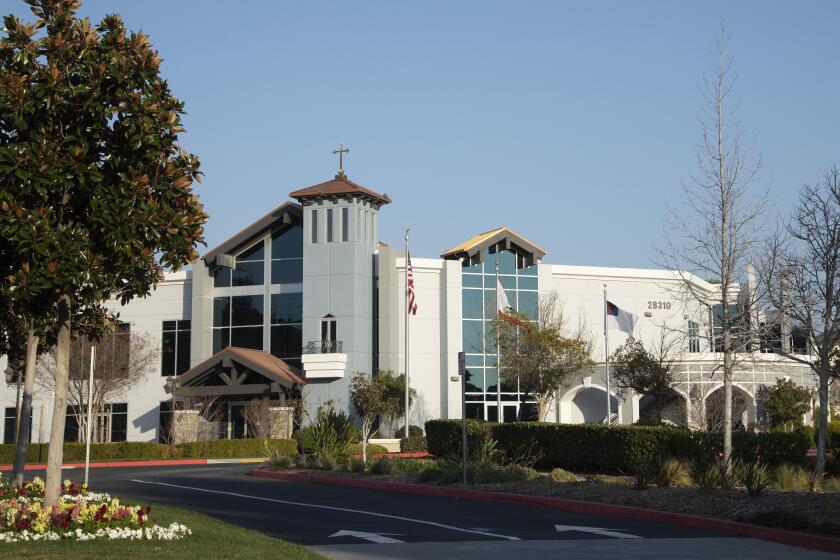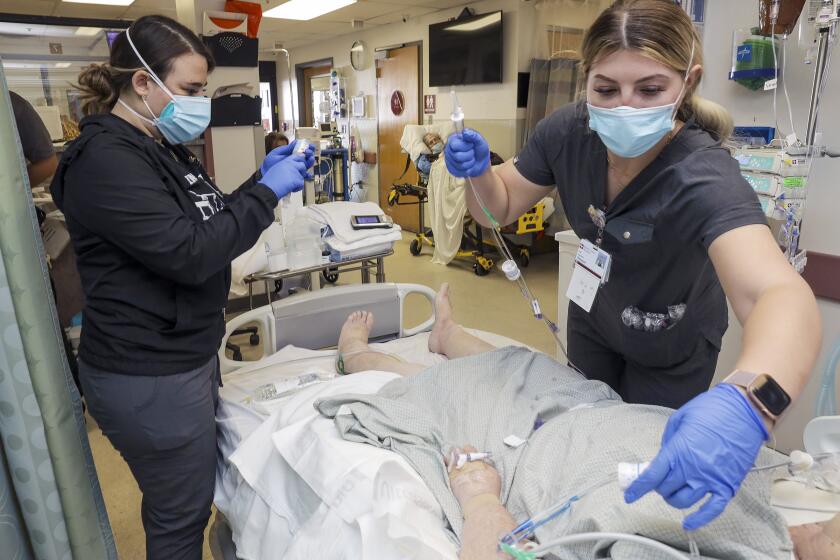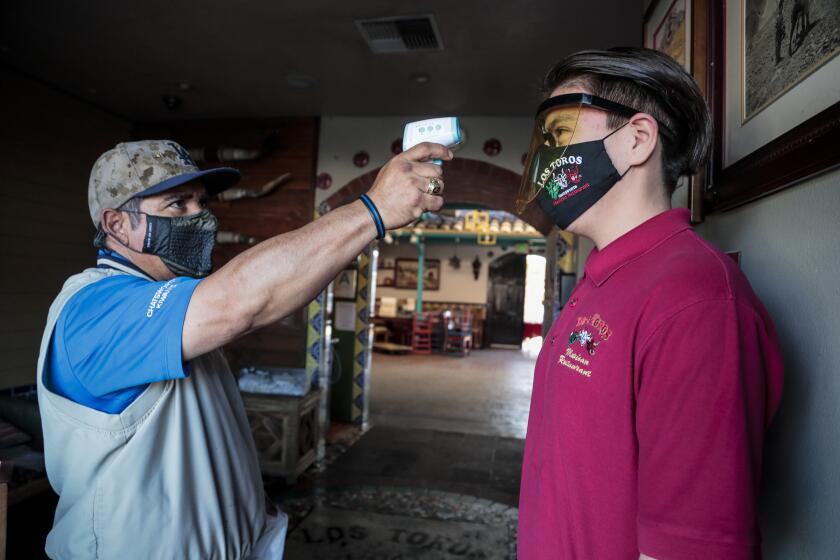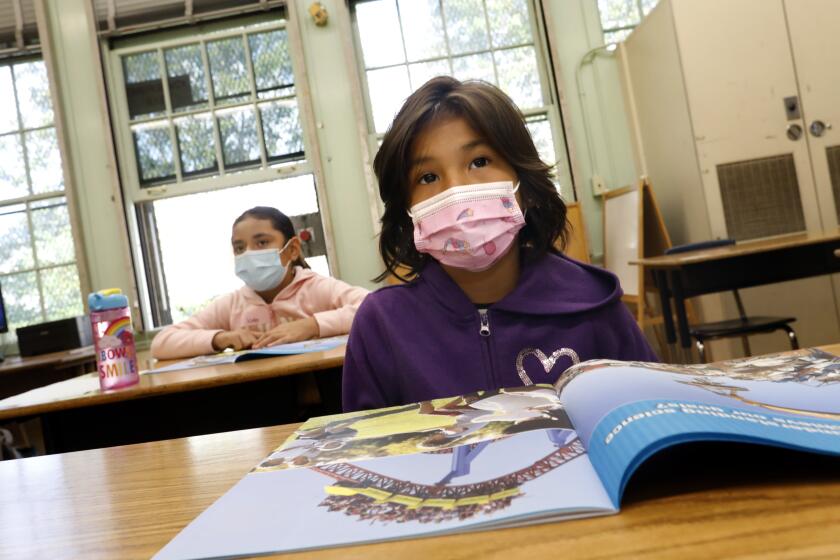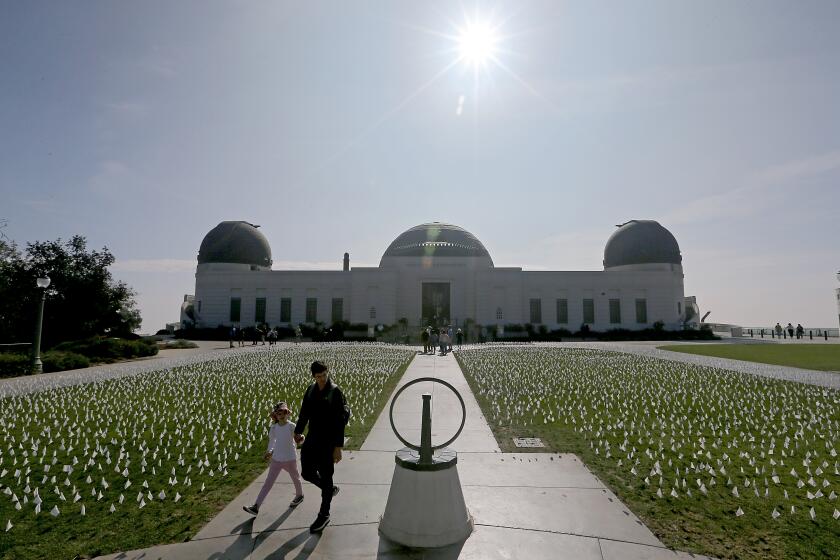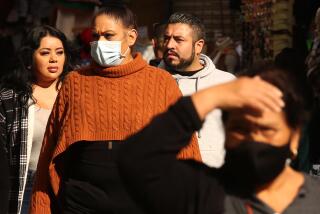California will lift mask mandate for vaccinated residents in indoor public places next week

Masks will still be required for unvaccinated residents indoors and for everyone in select settings such as hospitals and nursing homes or while aboard public transit.
- Share via
SAN FRANCISCO — With the Omicron coronavirus surge rapidly receding, California will lift its universal mask mandate for indoor public places next week, state officials announced Monday.
The lifting of the mandate will apply to counties without local mask orders of their own, such as San Diego, Orange, Riverside and San Bernardino counties, as well as swaths of the San Joaquin Valley. Counties can still opt to retain local mask orders, as Los Angeles County will do.
While this move doesn’t mean face coverings will be a thing of the past — they still will be required for unvaccinated residents indoors and for everyone in select settings, such as nursing homes or while aboard public transit — relaxing the roughly two-month-old order reflects the progress California has made in its battle against Omicron, even as officials say continued vigilance will be vital in keeping the state on the right track.
“Omicron has loosened its hold on California, vaccines for children under 5 are around the corner and access to COVID-19 treatments is improving,” said Dr. Tomás J. Aragón, the state’s director of public health and health officer. “With things moving in the right direction, we are making responsible modifications to COVID-19 prevention measures, while also continuing to develop a longer-term action plan for the state.”
California’s existing indoor mask mandate will remain in place through Feb. 15 as previously scheduled, officials said. At that time, the state will also increase the attendance thresholds for indoor and outdoor “mega events” — which are subject to additional recommendations and requirements surrounding coronavirus testing and vaccination verification — from 500 to 1,000, and 5,000 to 10,000, respectively.
In a sign of potentially more seismic moves to come, state officials also announced Monday they are working to update school masking requirements. Currently, everyone on a K-12 campus must wear masks indoors.
California isn’t alone in weighing such changes as much of the country emerges quickly from the latest COVID-19 wave. Just this week, officials in Connecticut, Delaware, New Jersey and Oregon also announced timelines for relaxing their own mask requirements.
The state also is lifting the requirement that visitors to hospitals and nursing homes test negative for the coronavirus.
During the pandemic a few schools have repeatedly thwarted L.A. County health inspectors from accessing their facilities, bringing on citations and fines.
While many are eager to return to pre-pandemic life, some public health officials and experts remain wary of removing all guardrails, aware that new coronavirus variants are possible in the months ahead. Hopes for a definitive end to the pandemic have been dashed many times, they say, and it would be unwise to drop both masking and vaccine requirements when such uncertainty remains.
Instead, some health officials and experts are urging smaller steps.
“This phase of the pandemic is nearing its end. I think that’s clear,” UC San Francisco epidemiologist Dr. George Rutherford said at a campus meeting last week. “What variants emerge after that is really pretty much anyone’s guess. ... There’s just no predicting them, unfortunately.”
Officials have long maintained that California’s COVID-19 response must evolve as conditions change.
But a recent poll by the Public Policy Institute of California found that COVID-19 remains the top issue on voters’ minds. While 67% of those surveyed said they believe the worst of the pandemic is behind us, that’s down significantly from last May, when 86% of respondents expressed that sentiment.
Gov. Gavin Newsom has typically received high marks for his response to the pandemic, though that is largely split along party lines. Democratic voters, who outnumber Republicans by almost 2 to 1 in California, have been supportive of Newsom’s COVID policies, but Republicans have been much more critical.
Mark Baldasarre, president and chief executive of the PPIC, said he thinks Monday’s announcement is “going to be received positively.”
“For the most part, people have found that the governor has handled the COVID situation to their liking,” Baldasarre said. “This is going to be welcome news.”
But he expects there will be some Californians who will question whether this is a good time to lift mask mandates and ease restrictions, reluctance that has existed throughout the deadly pandemic. Still, he said, Newsom’s cautious approach has given him more credibility when it comes to these decisions.
The governor’s pandemic response was one of the major arguments made by Republicans during the failed effort to recall him from office in September, and his COVID policies continue to be the focus of GOP leaders in Sacramento. Newsom also came under widespread criticism after photographs surfaced showing him momentarily maskless during a playoff game between the L.A. Rams and San Francisco 49ers, prompting charges of hypocrisy.
Regardless, Sacramento State political scientist Kim Nalder doesn’t expect the new masking policy or any of the recent events to have much of an impact on Newsom’s approval rating or his reelection prospects.
“I think that the recall results really bring that home, that his behavior has very little to do with his approval rating,” Nalder said. “We’re in our camps, politically. Democrats are going to support him whatever he does, and to some extent, Republicans will oppose it.”
Only about half the population in this rural desert area of San Bernardino County is fully vaccinated.
Ahead of the masking changes, some California counties are beginning to repeal vaccination mandates to enter certain businesses. Contra Costa County on Friday said it was lifting its vaccine-or-test requirement for customers of indoor restaurants, bars and gyms.
Health officials in the Bay Area’s third-most-populous county said the relaxation of the mandate, which has been in place since August, comes now that 80% of residents are fully vaccinated, and 2 in 5 residents have received a booster shot.
By contrast, in Los Angeles County, 69% of residents are fully vaccinated, and 1 in 3 residents have received a booster.
But other parts of the Bay Area are still toughening their vaccination rules. Last week, Oakland became the latest city in California to require proof of full vaccination to enter certain businesses. Similar rules are in place in West Hollywood.
Berkeley on Monday began requiring workers at restaurants, gyms and childcare facilities to receive a booster shot if they’re eligible. The city is also requiring all patrons age 5 and older to show proof of full vaccination to eat at indoor restaurants and enter indoor theaters.
San Francisco, however, has tweaked its requirements. The city partially softened its vaccination verification rule last week to allow certain indoor businesses to permit unvaccinated customers to enter if they cite religious beliefs or a qualifying medical reason. But they must show a recent negative coronavirus test — administered by a test provider and showing the person’s name — to enter.
For vaccinated San Francisco customers who don’t want to bother with getting a recent negative test, booster shots will now be required for entrance to certain locales for those who are eligible. San Jose made a similar adjustment Friday for indoor events of 50 or more people at city-owned sites.
San Francisco also eased its COVID-19 mask order for vaccinated gym members and office workers, allowing them to shed face coverings as long as they are up to date on their vaccinations and booster shots.
California officials hope the return of state-mandated COVID-19 sick pay will encourage infected workers to stay home and help slow transmission.
L.A. County Public Health Director Barbara Ferrer said there are still valid reasons behind the county order requiring vaccinations for customers of indoor bars, wineries, breweries, nightclubs and lounges, as well as the city ordinance mandating proof of full vaccination to enter other indoor businesses.
“We still have a lot of cases here, and we have a lot of transmission. And anything we can do to really help us get to a lower level of transmission, I think, is appropriate,” Ferrer said.
Unvaccinated people can still enter city businesses by voicing a religious exemption, but they need to show proof of a recent negative coronavirus test. Opponents are gathering signatures to either force the City Council to rescind the rules or put the issue on the ballot for voters to decide.
Health officials said face coverings no longer will be required in certain outdoor settings once COVID-19 hospitalizations drop by 26%, and indoor mask rules could be loosened after further gains.
L.A. County has outlined criteria by which it would lift mask requirements in certain outdoor settings once COVID-19 hospitalizations drop, and in which indoor mask rules would be loosened after further gains.
Supervisor Kathryn Barger has advocated for lifting the mask order. “Individuals should be allowed to make an informed choice about whether to mask up or not,” Barger wrote.
Supervisor Holly Mitchell, however, has supported the policy, noting it helps reduce rates of transmission.
“COVID-19 transmissions, quite frankly, disproportionately impact the everyday workers who make up the backbone of this very local economy,” said Mitchell, whose district has many Black and Latino residents who have suffered far worse health outcomes during the pandemic. “They are disproportionately brown and Black workers who must go to their jobs every day and interact with people every day.”
The sobering number undoubtedly will continue to climb in the days and weeks ahead even as the state emerges from the worst of this winter’s Omicron surge.
A new study by scientists at UC Berkeley and the California Department of Public Health further illustrated the effectiveness of masks in preventing coronavirus infection. Published by the U.S. Centers for Disease Control and Prevention, the study found that always wearing a mask in indoor settings resulted in being less likely to test positive for the coronavirus compared with those who didn’t routinely wear masks.
People who wore N95 or KN95 masks in public indoor settings had an 83% lower chance of testing positive; those who wore surgical masks had a 66% lower chance; and those who wore cloth masks had a 56% lower chance.
But some experts suggest that people will have to make personal decisions about whether to shed masks, even after the state mandate expires. UC San Francisco infectious diseases expert Dr. Peter Chin-Hong said he probably would continue wearing a mask in the near future in crowded indoor settings, such as at Costco. He’s also conscious about the possibility that having received his booster in October, his antibodies will again wane to the point that he may be more vulnerable to a breakthrough infection, although he’s confident about being protected against severe illness.
A number of doctors speaking at a campus discussion at UC San Francisco called for caution about shedding masks too quickly and warned there’s still a lot of uncertainty about what variants might emerge.
“March seems soon to me to take away masks. I think we need to see more time to understand what’s going to happen,” Dr. Sarah Doernberg, associate professor of infectious diseases at UC San Francisco, said. “It feels a little premature to take that away.”
Rutherford, who is also a board-certified pediatrician, cautioned against removing mask mandates in classrooms and day-care centers too quickly. For children ages 2 to 4, for whom there is no authorized vaccine, masks remain the best layer of protection, he said. An outbreak could cause a day-care center to close for perhaps 10 days.
For elementary, middle and high school students, who have had a chance to be vaccinated and, in some cases, boosted, “as transmission drops, we can back away,” Rutherford said. But dropping masks too quickly and potentially seeing a rise in outbreaks could result in large numbers of students being sent home for many days, and “I think that that’s a much greater disrupter of education than having masks on,” he said.
It’s also important to consider children who have underlying health issues and who could benefit from extended mask mandates. “There are lots of situations in which you might want to add an extra layer of protection. But I think, compared to keep sending everybody home every time there’s a case, masks are a much less intrusive kind of intervention,” Rutherford said.
Low vaccination rates among children are also a concern, experts caution. In San Francisco, 73% of children 5 to 11 years old are vaccinated with at least one dose, but in L.A. County, only 32% of children in the same age group are.
More to Read
Sign up for Essential California
The most important California stories and recommendations in your inbox every morning.
You may occasionally receive promotional content from the Los Angeles Times.
